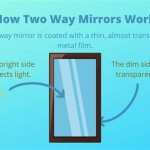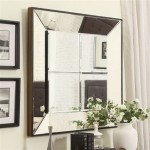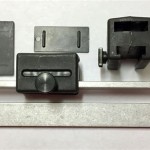How to Hang a Mirror Without Drilling Holes
Hanging a mirror can significantly enhance the aesthetic appeal of any room. Mirrors reflect light, making spaces feel larger and brighter. However, the traditional method of hanging mirrors, which involves drilling holes, can be daunting for many. Drilling can damage walls, create unsightly holes, and may not be suitable for renters or those who prefer to avoid permanent alterations to their living spaces. Fortunately, several alternative methods allow for secure and aesthetically pleasing mirror installation without the need for drilling. This article will explore various techniques and provide comprehensive guidance on how to hang a mirror without drilling holes.
Before embarking on any mirror hanging project, several preliminary steps are crucial. Proper preparation ensures the mirror is securely mounted and minimizes the risk of damage to the mirror or the wall. These steps include assessing the mirror's weight and size, evaluating the wall surface, and gathering the necessary tools and materials. Failing to adequately prepare can lead to instability and potential accidents.
Assessing the Mirror's Weight and Size
The first and arguably most important step is to accurately determine the weight and dimensions of the mirror. The weight of the mirror will dictate the type of adhesive or hanging system required. Lightweight mirrors, typically those weighing less than 10 pounds, can often be safely hung using adhesive strips or tapes. Heavier mirrors, on the other hand, necessitate stronger and more robust solutions. The dimensions of the mirror also play a role, as larger mirrors require more support to prevent sagging or detachment. Using a kitchen scale or a bathroom scale to measure the weight is advisable. For dimensions, a measuring tape will suffice.
It is critical to remember that the weight capacity advertised for various hanging solutions is often a maximum rating under ideal conditions. It is prudent to choose a hanging method with a weight capacity that significantly exceeds the actual weight of the mirror. A safety margin of at least 50% is recommended. For instance, if the mirror weighs 8 pounds, selecting an adhesive that is rated for at least 12 pounds provides an extra layer of security.
Evaluating the Wall Surface
The condition and type of wall surface play a vital role in determining the success of any no-drill hanging method. Smooth, clean, and non-porous surfaces, such as painted drywall or glass, provide the best adhesion for most adhesive-based solutions. Textured walls, such as those with heavy wallpaper or rough plaster, may not offer sufficient surface contact for adhesives to bond effectively. Walls with peeling paint or loose wallpaper require preparation before proceeding.
Before applying any adhesive, the wall surface must be thoroughly cleaned. Dust, dirt, and grease can impede adhesion and compromise the strength of the bond. Use a clean, damp cloth to wipe down the area where the mirror will be hung. For greasy or oily surfaces, a mild detergent solution can be used, followed by a rinse with clean water. Allow the wall to dry completely before proceeding with the installation. Consider using rubbing alcohol on walls that have a glossy finish to provide a better surface for the adhesive to bond too.
Furthermore, consider the type of paint on the wall. Some paints, particularly matte or eggshell finishes, can be more prone to peeling when adhesives are removed. In such cases, using a less aggressive adhesive or opting for a different hanging method might be preferable.
Gathering the Necessary Tools and Materials
Having all the necessary tools and materials readily available streamlines the installation process and minimizes the risk of errors. Essential items include: the mirror, the chosen hanging method (adhesive strips, mounting tape, or hook-and-loop fasteners), a level, a measuring tape, a pencil, a clean cloth, and, if applicable, a degreasing agent and a seam roller. A ladder or step stool may also be required for mirrors placed higher on the wall.
Ensure the chosen hanging method is appropriate for the weight and size of the mirror, as well as the type of wall surface. Read the manufacturer's instructions carefully and follow them precisely. Using the wrong type of adhesive or applying it incorrectly can result in the mirror detaching from the wall. For adhesive strips or tapes, select products specifically designed for hanging mirrors or heavy objects. Avoid using generic double-sided tapes, as they may not provide adequate adhesion.
A level is crucial for ensuring the mirror is hung straight. Use a bubble level or a laser level to verify the mirror's alignment. A measuring tape is necessary for accurately positioning the mirror and ensuring it is centered on the wall. A pencil is used to mark the desired location of the mirror and to guide the placement of the adhesive strips or hanging hardware.
Methods for Hanging Mirrors Without Drilling
Several no-drill methods are available for hanging mirrors, each with its strengths and limitations. The choice of method depends on factors such as the mirror's weight, the wall surface, and personal preferences. Common methods include using adhesive strips or tapes, mounting tape, hook-and-loop fasteners, and specialized hanging kits designed for heavy objects. Each will be discussed in detail.
Using Adhesive Strips or Tapes
Adhesive strips and tapes are a popular choice for hanging lightweight to medium-weight mirrors. These products are readily available at most hardware stores and home improvement centers. They typically consist of a strong adhesive on both sides, allowing for secure attachment to both the mirror and the wall. The effectiveness of adhesive strips depends on the quality of the adhesive, the surface preparation, and the weight of the mirror.
When using adhesive strips, it's crucial to distribute them evenly across the back of the mirror. Place strips along the top and bottom edges, as well as in the center, to provide balanced support. Follow the manufacturer's instructions regarding the number of strips required per pound of weight. Ensure that the strips are firmly pressed onto both the mirror and the wall to maximize adhesion.
One significant advantage of adhesive strips is their relatively clean removal. Many adhesive strips are designed to be removed without damaging the wall surface. However, it's essential to remove the strips carefully and slowly, following the manufacturer's instructions. Using a hairdryer to warm the adhesive can soften it and facilitate easier removal. This method will reduce the likeliness of paint peeling.
Employing Mounting Tape
Mounting tape, also known as double-sided foam tape, provides a stronger and more robust alternative to adhesive strips. Mounting tape is thicker and denser than adhesive strips, allowing it to conform to minor surface imperfections and provide a more secure bond. It is available in various widths and thicknesses, with different weight ratings. Selecting a mounting tape specifically designed for heavy objects and suitable for the wall surface is essential.
The application process for mounting tape is similar to that of adhesive strips. Clean the mirror and wall surface with the appropriate cleaning solution. Cut pieces of mounting tape to the necessary length and apply them to the back of the mirror, ensuring even distribution. Press the mirror firmly against the wall, holding it in place for the recommended amount of time (usually 30 seconds to a minute) to allow the adhesive to bond.
Mounting tape typically provides a stronger hold than adhesive strips. Because of that, it is more prone to causing damage to the wall upon removal. Exercise caution. The warming method of using a hairdryer is highly recommended. Slow and steady pressure when removing the tape is advised. In some cases, the adhesive may leave a residue on the wall, which can be removed with a mild adhesive remover.
Utilizing Hook-and-Loop Fasteners
Hook-and-loop fasteners, such as Velcro strips, offer a versatile and reusable option for hanging mirrors without drilling. These fasteners consist of two components: a hook side and a loop side. One side is attached to the back of the mirror, and the other is attached to the wall. When pressed together, the hooks and loops interlock, creating a secure connection.
Hook-and-loop fasteners offer the advantage of easy removal and re-positioning of the mirror. The mirror can be easily detached from the wall by gently pulling it away, separating the hooks and loops. This makes it a convenient option for those who like to rearrange their decor or who may need to remove the mirror for cleaning or maintenance.
When using hook-and-loop fasteners, ensure that the adhesive on the back of the strips is strong enough to support the weight of the mirror. Choose fasteners specifically designed for heavy objects and follow the manufacturer's instructions regarding weight capacity. Distribute the fasteners evenly across the back of the mirror to provide balanced support. One down side is that with heavier mirrors they can be more noticeable.
Employing Specialized Hanging Kits
Several specialized hanging kits are available that are specifically designed for hanging mirrors and other heavy objects without drilling. These kits often include a combination of adhesive strips, mounting hardware, and leveling tools. They are typically designed for specific weight ranges and wall types. Following the manufacturer's instructions carefully is essential for proper installation.
These specialized kits often offer a more secure and reliable hanging solution compared to using individual adhesive strips or tapes. They often include features such as adjustable hangers, which allow for fine-tuning the mirror's position after it has been hung. They may also include impact-resistant bumpers to protect the mirror from damage.
The downside of these kits is they can be more expensive than other options. However, the peace of mind and added security they provide may be worth the investment, particularly for heavier or more valuable mirrors. Always check the fine print and ensure the kit is exactly what is needed. Ensure that all materials are included when you purchase the kit.
Ultimately, hanging a mirror without drilling holes offers a viable and convenient alternative to traditional methods. By carefully assessing the mirror's weight and size, evaluating the wall surface, and selecting the appropriate hanging method, one can achieve a secure and aesthetically pleasing installation. Regardless of the method chosen, it is imperative to follow the manufacturer's instructions meticulously and exercise caution throughout the process to prevent damage or injury.

How To Hang A Mirror On Wall Without Nails

How To Hang A Mirror On Wall Without Nails Guide For All Diyers

3 Simple Ways To Hang A Mirror On Wall Without Nails Wikihow

3 Simple Ways To Hang A Mirror On Wall Without Nails Wikihow
How To Hang A 100 Pound Mirror On Drywall Quora

No Need To Drill A Hole In The Wall Mirror Or Picture Hanging For Als

How To Hang A Heavy Mirror Or Picture True Value

How To Hang A Mirror On Tile Wall Remington Avenue

How To Hang A Mirror On Tile Wall Remington Avenue

How To Hang Big Mirror Without Holes Tiktok Search








